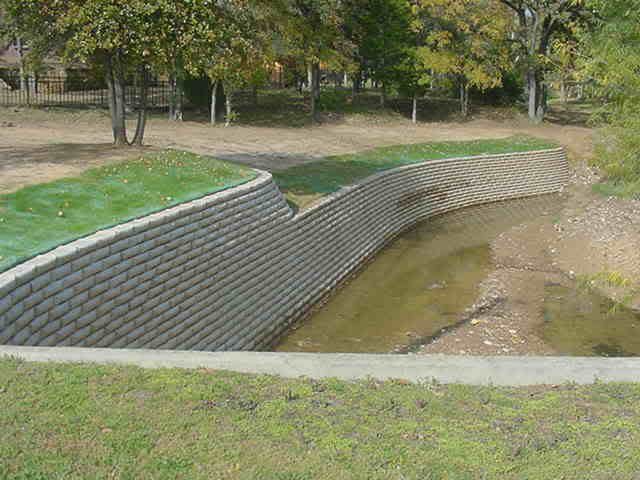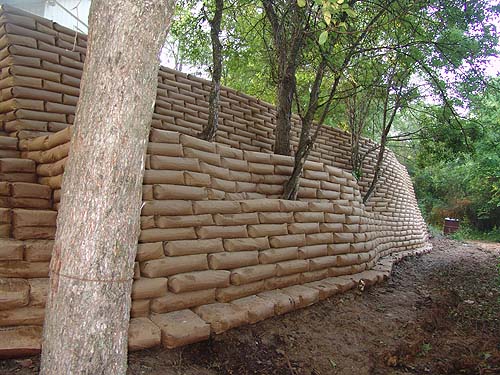 DIY 55 Gallon Aquaponics Project
DIY 55 Gallon Aquaponics Project Anyone started 3d printing stuff yet?
Anyone started 3d printing stuff yet? Food trailer power source
Food trailer power source Tractor thread
Tractor thread6 Feb ’14
 Offline
OfflineUPDATE
After my last posting I was left with some reservations and concerns. Rather than summarize, I'm going to do a walk through of where that led. My concerns were:
- Soil type - It was looking like I had clay soil. I was still awaiting results of a soil composition test. I remembered that it advised against clay for this purpose. I was concerned about weight bearing which clay is said to be less ideal at. I was also concerned about impermeable damming vs permeable, and I was concerned about erosion. I wanted to know what the recommended soil content was and wanted to know how much it could cost if I needed to truck in aggregate.
- Slope - After calculating for a 4:3 slope I realized that while that is the steepest slope recommended, that I had not looked at the slope recommendation for the purpose of raising to driveway elevation combined with a culvert.
- Drainage - Even though I opted for the higher of the recommended culvert diameters, I was still concerned about capacity during 20 to 100 year flood events. I was also concerned about using only 1 culvert pipe and creating a pinch point. The channel is 50 feet across and the low point is on the north side and flows about 7 feet broad. There is a second smaller natural channel on the south side which runs when the water level gets high enough. I was concerned about pooling.
I messed up my first attempt at a soil composition test (link pending), but have my result from the second attempt. I have clay soil. It was 80% clay, 15% silt, and 5% sand.
Referring back to http://ucanr.edu/sit.....138029.pdf, page 2 recommends:
Bedding and backfill material for culverts is commonly specified as "select granular material" or "select mineral soil". Actually, most soils are satisfactory if they are free of excessive moisture, muck, lumps of frozen soil, roots, highly plastic clay, or rock larger than 7.5 cm. Bedding material beneath the pipe should not have rocks larger than 3.8 cm. Clay soil can be used if it is carefully compacted at a uniform, near-optimum moisture content. Ideal backfill material is a moist, well-graded granular or sandy gravel soil with up to 10 percent fines and free of rocks. The material should be well compacted, at least as dense as the adjacent ground, and preferably at a density of 90-95% of the AASHTO T-99 maximum density. It should be placed in 15cm thick layers (lifts). A dense, uniform backfill is important to structurally support the lateral pressure from the pipe, particularly with plastic pipes.
Uniform fine sand and silt soils can be problematic when used for culvert bedding or backfill material. These fine, non-cohesive soils are very susceptible to scour and piping from moving water (Photo 8.6). Thus their use is discouraged. If used, they should be very well compacted against the pipe. Ideally, a clay plug or anti-seepage collar, made of metal, concrete, or even geotextile, should be placed around the culvert pipe to force any water channel to flow in a longer path through the soil. Concrete headwalls also deter piping.
So while it says "clay soil can be used if it is carefully compacted at a uniform, near-optimum moisture content", I would be concerned that achieving an "ideal and uniform" compaction and moisture content may not happen. I figure a higher safe margin of error is preferable.
So I looked up "select granular material" and discovered on https://www.dot.state.oh.us/Divisions/ConstructionMgt/OnlineDocs/2009MOP/SS%20840,%20850,851,%20S-1015/SS-840/SS.htm that you should:
bury the highly erosive select granular material and erosion can be minimized
"Highly erosive" concerned me as well. So lots of cover by gravel then lots of rip-rap on top of that? Or might there be something else? So I kept looking.
So returning to http://ucanr.edu/sit.....138029.pdf, page 6 shows an illustration with a 2:1 slope, and then on page 8 shows an illustration with a 1.5:1 slope. Much more conservative than the 4:3 slope. I generally favor opting for the conservative choice with such matters to increase margin of error. But a 2:1 slope would mean much more fill, and twice the length of pipe (6 sections instead of 3). I did the math. I did not like the result.
If I trucked in aggregate for a 4:3 slope, I was looking at 3 sections of 48 inch arch pipe to span 24 feet from toe edge to toe edge, and 24 truck loads for 409 cubic yards of fill. A 2:1 slope would mean 6 sections of 48 inch arch pipe to span 44 feet from toe edge to toe edge, and 25 truck loads for 522 cubic yards of fill. The cost of trucking in fill for the 4:3 slope would be about $4700, while the cost of trucking in fill for the 2:1 slope would be about $5300.
Even if I opted for the on site (clay) soil as fill to save money by not trucking in aggregate, I would want to have it excavated from the pond site and that creates the problem of moving the soil from the pond site at the top of the hill down to the stream crossing down in the valley. The more soil to move, and the farther it needs moving, the more expensive things get... again. And I'd still be stuck with having to get twice the length in arch pipe.
I stepped away to clear my head in the hopes of figuring out a better solution. (To be continued.)
6 Feb ’14
 Offline
OfflineUPDATE (Continued)
Retaining walls!!
What if I build cinder block retaining walls on each side? It would significantly reduce erosion, it would add stability and increase compaction potential of the local clay soil, and it would substantially reduce the amount of fill required. It would also eliminate the need for erosion control by gravel and rip-rap, and shorten the width to 16 feet only requiring 2 lengths of pipe!
Now my mental gears were turning...
- No gravel or rip-rap to truck in would save about $1150.
- Only needing 2 lengths of pipe, I could get 4 sections of 42 inch pipe giving me 2 spans for only about $120 more than it would cost to buy 3 sections of 48 inch pipe giving me only 1 span.
- 2 spans of 42 inch pipe would move an additional 20,698.4 gallons per minute (35,733.2 x 2 = 71,466.4) would eliminate having a pinch point, and would allow me to have a pipe at both low points reducing potential pooling.
So how would I do them, and how much would retaining walls cost?


I would do it cantilevered on each side and anchor the two sides to each other and to the 2 spans of arch pipe with a cross braced ridge wall along the top center line of each span of pipe mortaring it all together.
Here are some cost guesstimates...
- 652 cinder blocks would cost about $1075
- rebar about $270
- remesh about $120
- rebar ties about $15
- 8.02+ cubic yards for concrete footings (awaiting price quote)
- 6.04+ cubic yards for concrete block fill (awaiting price quote)
- mortar etc unknown
That's $1480 known + $120 more on pipe = $1600 - $1150 saved = $450 over thus far. I'm certain these numbers will look much different before this is done.
I'm still largely in the dark for how to do this properly. I'm likely off in my estimate of materials so I'd welcome input.
Here are some numbers. I estimated for the following...
- 652 cinder blocks measuring 16"x8"x8" for 2 walls measuring 50'Lx6'H each with 2 gaps for arch pipe measuring 60"Wx40"H per gap, and 2 cross braced ridges measuring 16'Lx16"H each. (I just caught an error. I should have subtracted 16" from the 16' for 14'8"L which would be 8 blocks fewer making the total blocks 644 instead.)
- 10 6' rebar per wall
- 4 2.5' rebar per wall
- 4 16" rebar per cross braced ridge
- 10 6' rebar elbow risers per footing side (80 ties)
- 12 6' rebar short span per footing side (96 ties)
- 10 10' rebar long span per footing side (32 ties)
- 1 roll of 5' x 150' remesh (172 ties)
- 380 rebar ties (sold in 1000 pack)
- 4.01+ cubic yards of ready mix concrete per footing measuring 2"H x 600"L x 78"W per side
- 6.04+ cubic yards of ready mix concrete block fill (652 blocks x .25 cuft void space each = 163 cuft void space = 6.04 cuyds)
- I planned to set the blocks 16" from the outside edge of each footing. That allows enough space to add a second thickness of block later if I want and still have an 8" toe.
That's it for now.
6 Feb ’14
 Offline
OfflineKVR said
what about cement bags for a rip wall, stack em, pinem,water them down
I was reminded of those while searching pics of retaining walls. Near as I can tell, it would be a gravity supported wall, no reinforcement, and no anchoring. Honestly I wouldn't feel safe. I'd always fear it toppling over as I was trying to drive over it.
That does remind me though about your surface bonded walls supporting the weight of your berm. I need to look back over that.
6 Feb ’14
 Offline
OfflineI just had another thought. If I'm doing form work, rebar, remesh, and ready mix concrete, what if I did my own culverts and direct the money I'd spend on precast into that? Also, I wonder how much it would cost to pour steel reinforced ready mix concrete retaining walls vs cinder blocks?
Does it count as monolithic if done in multiple pours/drys/stages? As in slab first, then culverts, then retaining walls?
Most Users Ever Online: 698
Currently Online:
47 Guest(s)
Currently Browsing this Page:
1 Guest(s)
Top Posters:
easytapper: 2149
DangerDuke: 2030
groinkick: 1667
PorkChopsMmm: 1515
Gravel Road: 1455
Newest Members:
Forum Stats:
Groups: 1
Forums: 12
Topics: 11482
Posts: 58640
Member Stats:
Guest Posters: 2
Members: 19842
Moderators: 0
Admins: 1
Administrators: K

 Log In
Log In Home
Home











